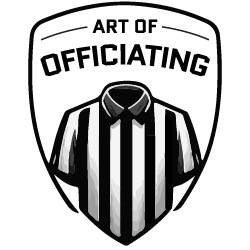Here is a Ray Lutz “Forward Progress” post from September 27, 2011 (Edited for clarity)
When we report a foul to the Referee, we want to make it as clear and as concise as we possibly can. This thought is especially relevant when a change of possession is involved. We don’t want the Referee to have to transpose or convert any more information than is absolutely necessary.
Therefore, instead of telling him “White” or “Blue,” or “Doherty” or “Mitchell,” all of which would require the Referee to convert to Team A or Team K, let’s report in those casebook terms and save the referee the need to convert information. This will speed up the administration process, and in the case of changes of possession, it will lessen the chances of confusion.
So, instead of reporting, “I have an illegal block in the back on Doherty during the kick and a facemask by Wasson during the return,” let’s try, “I have a block in the back on R during the kick and a facemask on K during the return.” This way, there is less transposing for the Referee to do, and he can think in “casebook” terms right from the beginning of the penalty administration process.
Mark’s additional comment:
It’s also important for the reporting official to clearly state the timing of each foul. For example, during a scrimmage kick, was a foul by Team R before the kick ended (resulting in PSK enforcement), or was it after the kick ended during the ensuing run (resulting in spot-comparison enforcement).
Keep in mind that not every official is a referee, so it can be difficult for them to articulate the foul in “white-hat terms,” even though that’s the goal. Referees will work with crewmates who have varying levels of communication skills, and sometimes clarification will be needed. That means the referee must be proactive in asking the right questions to get complete information.
It’s often useful to ask whether the foul was live-ball or dead-ball if that detail isn’t immediately provided by the reporting official. We also can’t assume when the foul occurred in relation to a change of possession. If the reporting official doesn’t specify, the referee should ask.
Quiz
Read the quiz stem and then choose the best answer.
True or False. The home team’s head coach disagrees with a judgment call made by the back judge. The line judge acknowledges the coach’s concern and explains that he will confer with the back judge at the next opportunity to hear his explanation. For the next 5 minutes, the head coach continues to vehemently object. The line judge has the option of issuing a sideline warning.
- True
- False
Review Rules 9-8-1d and 9-8-3 PENALTY
